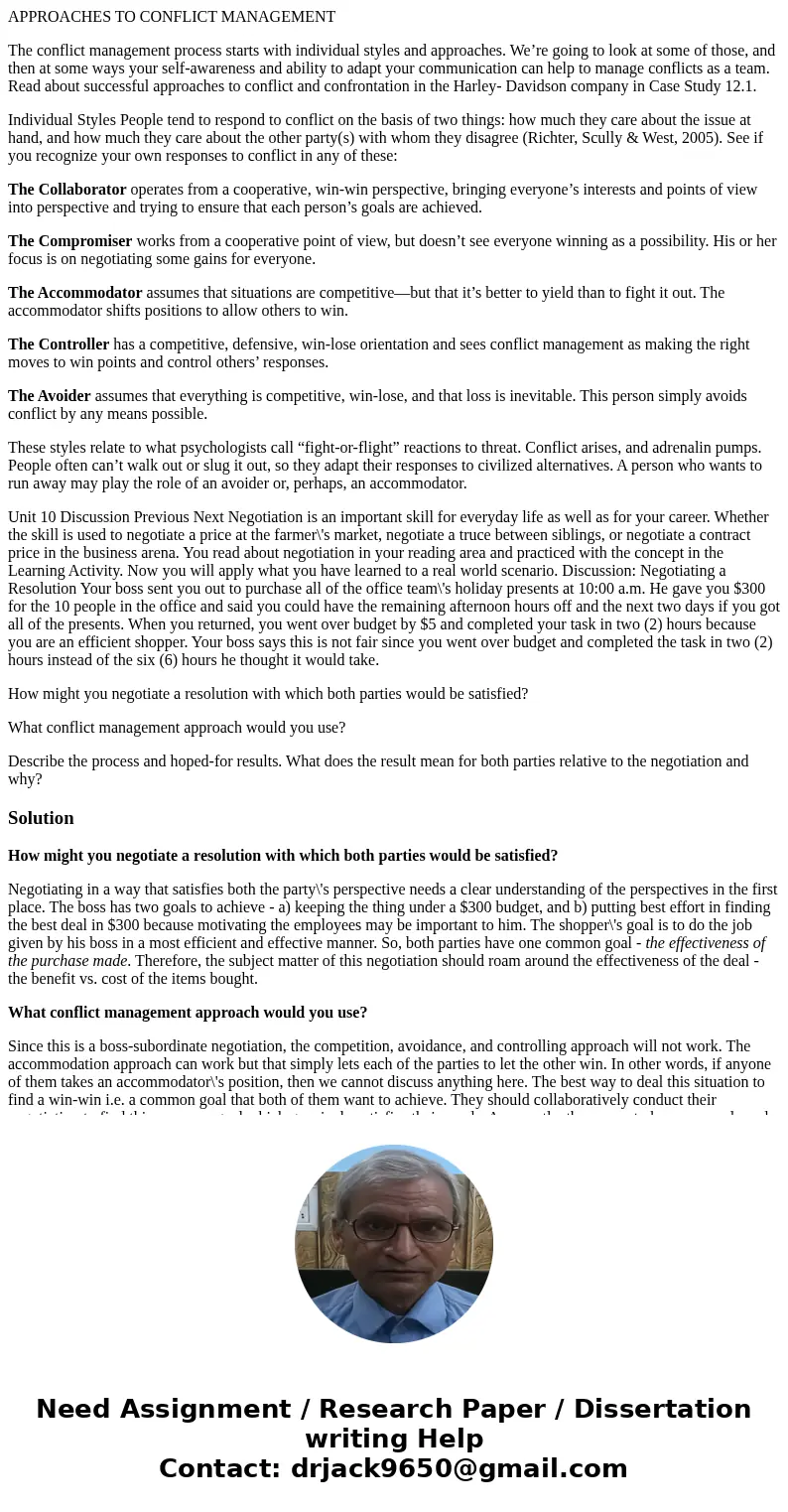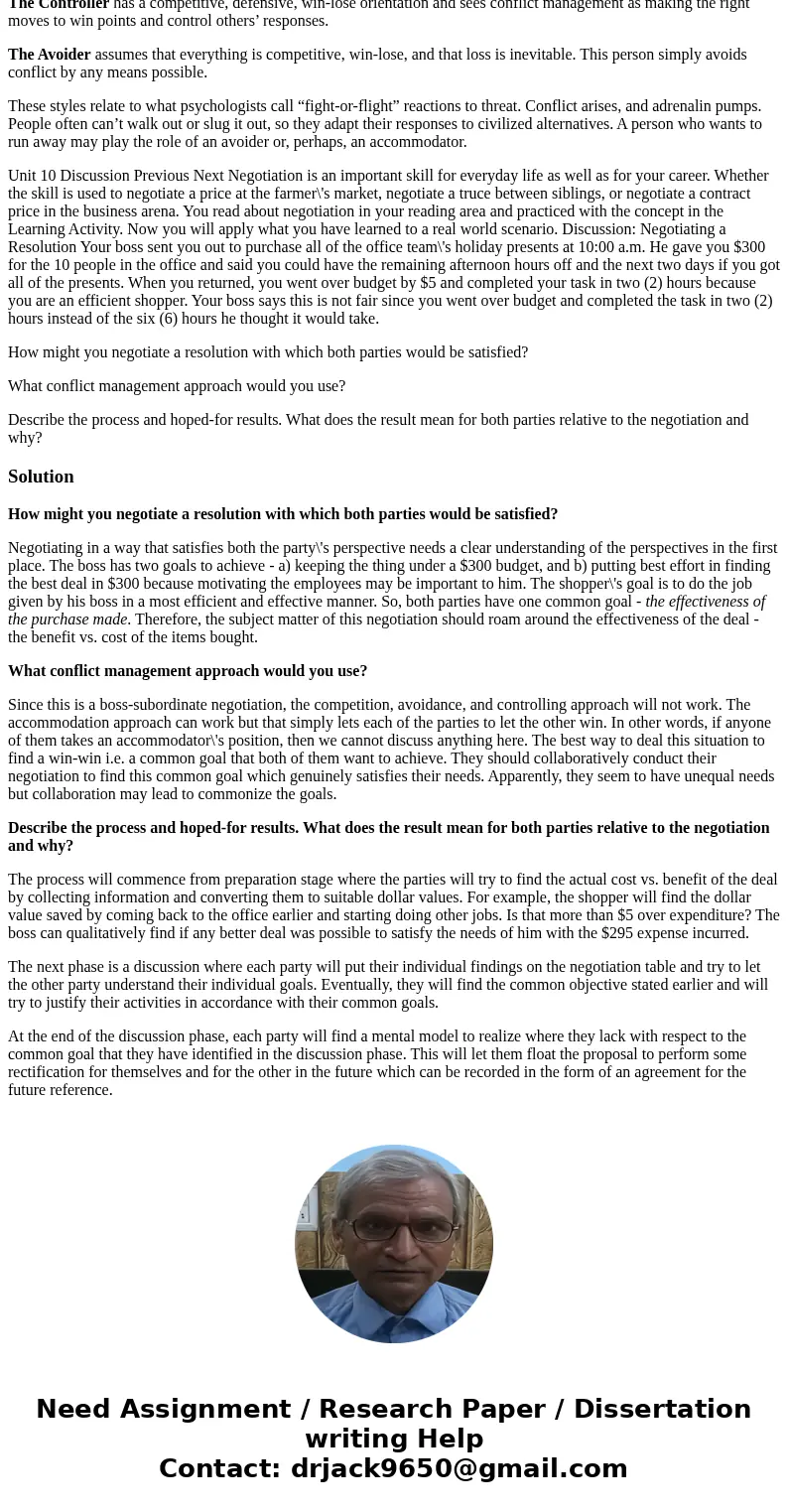APPROACHES TO CONFLICT MANAGEMENT The conflict management pr
APPROACHES TO CONFLICT MANAGEMENT
The conflict management process starts with individual styles and approaches. We’re going to look at some of those, and then at some ways your self-awareness and ability to adapt your communication can help to manage conflicts as a team. Read about successful approaches to conflict and confrontation in the Harley- Davidson company in Case Study 12.1.
Individual Styles People tend to respond to conflict on the basis of two things: how much they care about the issue at hand, and how much they care about the other party(s) with whom they disagree (Richter, Scully & West, 2005). See if you recognize your own responses to conflict in any of these:
The Collaborator operates from a cooperative, win-win perspective, bringing everyone’s interests and points of view into perspective and trying to ensure that each person’s goals are achieved.
The Compromiser works from a cooperative point of view, but doesn’t see everyone winning as a possibility. His or her focus is on negotiating some gains for everyone.
The Accommodator assumes that situations are competitive—but that it’s better to yield than to fight it out. The accommodator shifts positions to allow others to win.
The Controller has a competitive, defensive, win-lose orientation and sees conflict management as making the right moves to win points and control others’ responses.
The Avoider assumes that everything is competitive, win-lose, and that loss is inevitable. This person simply avoids conflict by any means possible.
These styles relate to what psychologists call “fight-or-flight” reactions to threat. Conflict arises, and adrenalin pumps. People often can’t walk out or slug it out, so they adapt their responses to civilized alternatives. A person who wants to run away may play the role of an avoider or, perhaps, an accommodator.
Unit 10 Discussion Previous Next Negotiation is an important skill for everyday life as well as for your career. Whether the skill is used to negotiate a price at the farmer\'s market, negotiate a truce between siblings, or negotiate a contract price in the business arena. You read about negotiation in your reading area and practiced with the concept in the Learning Activity. Now you will apply what you have learned to a real world scenario. Discussion: Negotiating a Resolution Your boss sent you out to purchase all of the office team\'s holiday presents at 10:00 a.m. He gave you $300 for the 10 people in the office and said you could have the remaining afternoon hours off and the next two days if you got all of the presents. When you returned, you went over budget by $5 and completed your task in two (2) hours because you are an efficient shopper. Your boss says this is not fair since you went over budget and completed the task in two (2) hours instead of the six (6) hours he thought it would take.
How might you negotiate a resolution with which both parties would be satisfied?
What conflict management approach would you use?
Describe the process and hoped-for results. What does the result mean for both parties relative to the negotiation and why?
Solution
How might you negotiate a resolution with which both parties would be satisfied?
Negotiating in a way that satisfies both the party\'s perspective needs a clear understanding of the perspectives in the first place. The boss has two goals to achieve - a) keeping the thing under a $300 budget, and b) putting best effort in finding the best deal in $300 because motivating the employees may be important to him. The shopper\'s goal is to do the job given by his boss in a most efficient and effective manner. So, both parties have one common goal - the effectiveness of the purchase made. Therefore, the subject matter of this negotiation should roam around the effectiveness of the deal - the benefit vs. cost of the items bought.
What conflict management approach would you use?
Since this is a boss-subordinate negotiation, the competition, avoidance, and controlling approach will not work. The accommodation approach can work but that simply lets each of the parties to let the other win. In other words, if anyone of them takes an accommodator\'s position, then we cannot discuss anything here. The best way to deal this situation to find a win-win i.e. a common goal that both of them want to achieve. They should collaboratively conduct their negotiation to find this common goal which genuinely satisfies their needs. Apparently, they seem to have unequal needs but collaboration may lead to commonize the goals.
Describe the process and hoped-for results. What does the result mean for both parties relative to the negotiation and why?
The process will commence from preparation stage where the parties will try to find the actual cost vs. benefit of the deal by collecting information and converting them to suitable dollar values. For example, the shopper will find the dollar value saved by coming back to the office earlier and starting doing other jobs. Is that more than $5 over expenditure? The boss can qualitatively find if any better deal was possible to satisfy the needs of him with the $295 expense incurred.
The next phase is a discussion where each party will put their individual findings on the negotiation table and try to let the other party understand their individual goals. Eventually, they will find the common objective stated earlier and will try to justify their activities in accordance with their common goals.
At the end of the discussion phase, each party will find a mental model to realize where they lack with respect to the common goal that they have identified in the discussion phase. This will let them float the proposal to perform some rectification for themselves and for the other in the future which can be recorded in the form of an agreement for the future reference.


 Homework Sourse
Homework Sourse